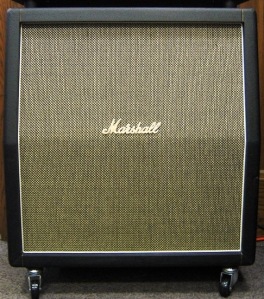The following article addresses how different cabinet types impact guitar tone – the three most common cabinet types in particular: closed-back, open-back and oval-back. Not only do different speaker types and brands affect amplifier tone dramatically, the cabinet that your speakers are installed in shape that tone to practically the same degree. The following information explains the tonal characteristics of these different types of guitar amp speaker cabinets:
Closed-back Cabinets
A general rule of tone is simply that the bigger the box, the lower the frequency response of a closed-back cab. Yet, this is only true up to the point where a speaker can no longer produce lower frequencies. In a closed-back cabinet the sound waves produced from the back of the speaker simply bounce around inside the cabinet until they dissipate or “die.” And, as the back half of the speaker is in a partial vacuum, the speaker usually takes a little more power to get moving, so fast initial transient peaks can be a bit muted and be perceived as less loud than an open back cabinet – all other factors being equal. Additionally, closed-back cabinet designs can be darker toned than open-back cab designs.
Many old speaker cabinet designs used closed cabinets, and the frequency response was usually good, despite the fact that almost no design work was performed, as we see with Marshall cabinets and the like. Closed-back cabinets are not very room or position dependent and can be used in most any live context. With a closed-back cabinet design, bass response is increased, though high-end “airiness” is decreased. A closed back cab will have more bottom end thump. It is also important to note that closed-back cabinets will sound dramatically different at various axis points (where the listener is located relative to the front of the cabinet). In general a closed back produces a more rock to hard rock tone. An open-back cabinet is arguably best for blues into rock tone, producing a looser and more airy tone that fills a room all around more.
Open-back Cabinets
With open-back cabinets too, the bigger the box is, the lower the frequency response. And, especially with open back cabinets, the baffle-board that the speaker(s) is installed on impacts tone greatly too, so be aware of the baffle board that is utilized. Open-back cabinets mainly behave like dipoles – meaning sound is projected both forward and backward. Additionally, a good strong tone is dependent on reflections from behind the cabinet too. This makes for that expansive, open and airy sound. However, this comes at the expense of bass response. For, as sound is produced by both the front and the back of a speaker, open backed cabs can suffer phase cancellation problems as the sound produced by the back of the speaker is naturally 180 degrees out of phase with the sound produced by the front of the speaker. This can result in an unnatural sounding midrange and absent low mids/bass frequencies.
Of course the affects of this can be altered by room placement amongst other things. And, tone can differ a lot based on one’s position relative to the amp in the room. You have to good walls and surfaces for the rear-projecting tones to reflect off of to best use an open-back cab. Outdoors or in places where you have to jam the cab up against a wall just doesn’t work well. Additionally, both open and oval-back cabs will suffer the same fate pushed up against a wall. Open and oval-back cabinet designs (especially open-back) are very room and position dependent. Additionally, an open back cab will give you more volume, and the high end will be apparent further off axis.
Oval-back Cabinets
Those not very familiar with oval-back cabinets really need to look into this lessor known yet extremely effective cabinet design. As was all cabinets, the bigger the cabinet box is, the lower the frequency response of an oval-back system, as well. Factors like the baffle are key, as different thicknesses will all have different effects on tone. Same with the back opening – different resonances occur when you use different port sizes or openings, making various colorful sounds. Also, an oval back cab loads up the driver more and makes for a tighter sound with more bottom-end, yet with an opening back there, sound gets out and reflects off the back wall making for that more spacious sound.
The size of the oval port is were a lot of tone shaping comes into play. With a smaller size hole, a cabinet will behave more like a ported cab than an open back cab. Various openings raise or lower the frequency where the rear waves become out of phase with the front and attenuate sound. The right size can add bottom-end extension and smooth out the lower midrange. Both a small oval opening acting like a port and various size oval openings facilitating less phase-cancellation at a lower frequencies, can create more bottom-end. So, various openings create more low-end – just in different ways based on the size.

